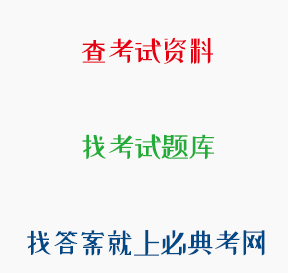[单选题]放学后,几名学生到教师王某私自开设的学校附近的商店里,购买了过期食品,导致食物中毒。对这起事故应承担的主要责任的是( )。
正确答案 :A
王某
解析:《学生伤害事故处理办法》第八条规定,因学校、学生或者其他相关当事人的过错造成的学生伤害事故,相关当事人应当根据其行为过错程度的比例及其与损害后果之间的因果关系承担相应的责任。题目中,教师王某是私自开设商店,出售过期食品,属于个人因素导致的学生受到伤害,因此要承担主要责任。故选择A。
[单选题]中国研制成功的第一台亿次巨型计算机是( )。
正确答案 :A
银河-I
解析:1983年12月22日,国防科技大学研制成功我国第一台亿次巨型计算机银河-I,运算速度每秒1亿次。故选择A。B选项,"银河-II计算机,1994年研制成功,运算速度每秒10亿次。世界上运算速度最快的超级计算机,是中国研制的"天河-II",峰值计算速度每秒5.49亿亿次。C、D选项,巨浪系列是中国研制的潜射弹洲际道导弹,可以从核潜艇中发射,携带常规弹头或核弹头,射程数干公里,是我国战略核反击的中坚力量。
[单选题]美国生理和心理学家格赛尔首次将成熟概念移用到教育研究之中。他认为,人的机体的成熟程度制约着身心发展的程度。成熟与教学的效果是契合的,一种技能的发展由成熟支配时,没必要超前加以训练。这一结论来自他曾做过著名的( )。
正确答案 :C
爬楼梯实验
解析:格赛尔用双生子爬楼梯实验证明了成熟机制的作用。黑猩猩实验的操作者是苛勒,并由此提出了顿悟说。
[单选题]终身教育理论体系最终形成是以联合国教科文组织的( )为标志的。
正确答案 :C
《教育一一财富蕴藏其中》
解析:终身教育理论的迅速发展,代表性的著作有法国成人教育家保罗·朗格朗1970年出版的《终身教育导论》、埃德加·富尔的《学会生存一一教育世界的今天和明天》。联合国教科文组织发表的报告《教育一一财富蕴藏其中》是终身教育理论体系最终形成的标志。
[多选题]布鲁姆把教学目标分为"认知领域""情感领域"和"道德领域"三个方面。( )
正确答案 :
解析:布鲁姆把教育目标分为认知、情感和动作技能三大领域。
[单选题]痛觉的生物学意义在于( )。
正确答案 :C
它对身体具有保护性作用
解析:痛觉是有机体受到伤害性刺激所产生的感觉,有重要的生物学意义。它是有机体内部的警戒系统,能引起防御性反应,具有保护作用。
[单选题]了解智力活动的动作结构,明确活动的方向的阶段是( )。
正确答案 :A
原型定向
解析:原型定向就是了解心智活动的实践模式,了解"外化"和"物质化"了的心智活动方式或操作活动程序,了解原型的活动结构(动作构成要素,动作执行次序,动作执行要求),从而使主体知道该做哪些动作和如何去完成这些动作,明确活动的方向。
[单选题].经验类化理论强调概括化的经验或原理在迁移中的作用,是由贾德提出的。( )A.正确B.错误
正确答案 :
解析:经验类化理论又称概括化理论,强调概括化的经验或原理在迁移中的作用,是由美国心理学家贾德提出的。
[单选题]教育者施教传道和受教育者受教修养的相互作用的活动方式称为( )。
正确答案 :C
德育方法
解析:德育方法是为达到德育目的,在德育过程中采用的教育者和受教育者相互作用的活动方式的总和。它包括教育者的施教传道方式和受教育者的受教育方式。故选择C。
[单选题]Passage 1
Today's adults grew up in and economic system. The amount of time available to learn was fixed: one year per grad amount learned by the end of that time was free to vary: some of us learned a great deal;some, very little. As we advanced through the grades,those who had learned a great deal in previous grades continued to build on those foundations. Those who had failed to master the early prerequisites with in the allotted time failed to learn that which followed. After 12 or 13 years of cumulative treatment of this kind, we were, in effect, spread along an achievement continuum that was ultimately reflected in each students rank in class upon graduation.
From the very earliest grades, some students learned a great deal very quickly and consistently scored high on assessments. The emotional effect of this was to help them to see themselves as cap-able learners, and so these students became increasingly confident in school. That confidence gave them the inner emotional strength to take the risk of striving for more success because they believed that success was within their reach. Driven forward by this optimism, these students continued to try hard, and that effort continued to result in success for them. they became the academic and emotional winners. Notice that the trigger for their emotional strength and their learning success was their perception of their success on formal and informal assessments.
But there were other students who didn't fare so well. They scored very low on tests, beginning in the earliest grades. The emotional effect was to cause them to question their own capabilities as learners. They began to lose confidence, which, in turn, deprived them of the emotional reserves needed to continue to take risks. As their motivation warned, of course, their performance plummeted These students embarked on what they believed to be an irreversible slide toward inevitable failure and lost hope. Once again, the emotional trigger for their decision not to try was their perception of their performance on assessments.
Consider the reality--indeed, the paradox--of the schools in which we were reared. If some students worked hard and learned a lot, that was a positive result, and they would finish high in the rank order. But if some students gave up in hopeless failure, that was an acceptable result, too, because they would occupy places very low in the rank order. Their achievement results fed into the implicit mission of schools: the greater the spread of achievement among students, the more it rein-forced the rank order. This is why, if some students gave up and stopped trying(even dropped out of school) that was regarded as the students problem not the teachers or the school's.
Once again, please notice who is using test results to decide whether to strive for excellence or give up in hopelessness. The "data-based decision makers"in this process are students themselves Students are deciding whether success is within or beyond reach, whether the learning is worth the required effort, and so whether to try or not. The critical emotions underpinning the decision making process include anxiety, fear of failure, uncertainty, and unwillingness to take risks all triggered by students' perceptions of their own capabilities as reflected in assessment results.
Some students responded to the demands of such environments by working hard and learning a great deal. Others controlled their anxiety by giving up and not caring. The result for them is exactly the opposite of the one society wants. Instead of leaving no child behind, these practices, in effect,drove down the achievement of at least as many students as they successfully elevated. And the evidence suggests that the downside victims are more frequently members of particular socioeconomic and ethnic minorities.
Passage 1
Which of the following describes the paradox of the schools?
正确答案 :D
Students' perception and the reality of their performance on assessments
解析:根据关键词定位到第四段。根据原文“Their achievement results fed into the mplicit mission of schools: the greater the spread of achievement among students, the more it reinforced the rank order. This is why, if some students gave up and stopped trying(even dropped out of school), that was regarded as the student's problem, not the teacher's or the school's.可知,学生之间成绩流传得越广,成绩的排名就越固定。结合前文及此处内容,也就是说成绩决定了学生学习的态度,态度决定了他们的排名表现。故选择D。
查看原题 查看所有试题

 川公网安备 51012202001360号
川公网安备 51012202001360号